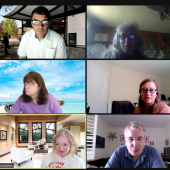Competitive SERP analysis (including our recently launched Competitive Analysis Suite) is — by design — based on understanding the broader ecosystems of your ranking keywords. This is great if you’re an established business, but what if you’ve got a brand new site or are still developing your SEO strategy and aren’t ranking for many keywords?
Consider, for example, the fictional site, Dice-E-Shop.com (shh.. just let me have this one). We plug it into True Competitor, wait for some magic to happen, and voila!

Look at all the time you saved!
Okay, it’s not ideal, but there is a solution, and I call it “Aspirational Analysis”. The basic idea is simple — find a few aspirational but realistic keywords (ones that you can hope to compete for in the mid-term), use those SERPs to find aspirational competitors, and analyze those competitors to chart your competitive course.
1. Aspirational keywords
Let’s assume that you don’t know your competitive SEO landscape very well or that you want a fresh perspective on it. What you do know, hopefully, is the general topic and keyword space you want to compete in.
Let’s take our fictional business, Dice-E-Shop.com, and let’s pretend that it’s an online store specializing in handmade tabletop gaming dice. The key to step one is being aspirational but realistic — no vanity keywords allowed.
I’m not trying to make you feel bad. This is purely pragmatic. For example, let’s plug the keyword “dice” into our Keyword Explorer tool. You should get something like this:

That volume may look nice, but not only is the Keyword Difficulty pretty high, but look at that estimated CTR. Let’s take a quick look at the SERP itself …

The #1 organic position is occupied by a job search brand called Dice.com, which also has expanded sitelinks and other brand-specific rankings (such as their LinkedIn page). That brand is going to soak up most of the clicks on page one. This is neither a realistic nor desirable keyword.
I’m going to simplify this process to keep the workflow reasonable, but the next step is a blend of SERP analysis and intuition. We could go down many descriptive paths (“wooden dice”, “DnD dice”, “artisan dice”, etc.), but let’s try out “handmade dice”:

Don’t get hung up on the volume — our aspirational keyword(s) is all about finding a relevant, realistic competitor. It’s not about building a target keyword list. In this case, just by moving to a two-word phrase, we’re in a more reasonable Keyword Difficulty range with a much more attractive potential for organic clicks. In a more competitive market, we might need to reach deeper into the long tail of search, but “handmade dice” will do nicely for now.
2. Aspirational competitors
Let’s dig into the SERP for “handmade dice” a bit. The #1 result is for Etsy, but while they’re probably a good source of competitive intelligence for our new shop, they’re obviously not a realistic SEO competitor.
Here are the next three organic results. I’ve turned on the MozBar Chrome extension to quickly gain some additional insight:

The #2 site has a pretty low Domain Authority (13), and might not have a lot of ranking data. Honestly, though, as a marketer, I’m stuck on the #4 site because of this:

Love it or hate it, that’s certainly a unique selling proposition. What’s great about this analysis is that you can’t really pick the wrong site. This is an exploration of the competition, and you can always loop back and take another path and journey.
So, let’s go back over to True Competitor and plug in ArtisanDice.com. You’ll get back something like this (edited for size):

Due to a high keyword overlap (at 22%), Etsy scores high on our Rivalry metric, but, as previously discussed, is out of reach. Immediately after, though, we get a number of sites that look pretty viable, and we could easily visit those sites or research them in Keyword Explorer to learn more. Even the site that doesn’t look relevant at first glance (Help-action.com) turns out to be a blog for Dungeon Master resources and might have useful content ideas.
3. Aspirational analysis
I’d argue that we’ve already unearthed some pretty interesting information, but let’s take it a step further. I’m going to plug those top three aspirational competitors (after Etsy) into our new Keyword Gap tool. Here’s a sampling of the competitive keyword gap:

Note that, because we’re using an aspirational competitor (and not our own site), the “Traffic Lift” and “Your Rank” data have to be interpreted differently. This report is from the perspective of our aspirational competitor (ArtisanDice.com).
That said, we’ve got a solid start to finding opportunities in the space and keywords our soon-to-be competitors are targeting. We can easily start to piece together themes, like popular materials, which may even inform our product decisions.
The “Top Competing Content” report gives us a glimpse at some of the most effective content from our aspirational competitors, including a sampling of ranking keywords. I’ve edited this list down to show a few patterns, including pages themed around stone dice and d20s:

Now, we can explore these pages directly for inspiration. We could even put these pages back into our “Explore by Site” tool in Keyword Explorer and get keywords for the exact URL:

This niche page (targeting oversized d20s) ranks for 43 keywords in our data, including:
-
oversized d20
-
giant d20s
-
large 20 sided dice
-
jumbo 20 sided dice
-
oversized d20 dice
-
massive d20
-
huge 20 sided dice
-
giant d20 die
Even a sampling of this list is rich with synonyms and the kind of natural-language terms you should consider when building content around this niche.
4. Aspirational automation
While I’ve written this workflow around Moz tools, there are many ways to go about it, including manually using the SERPs themselves. There are two benefits to automation, though, and why I hope our Competitive Analysis suite can empower you to do better work faster.
First, even knowing very little about this space (other than being an occasional gamer and owning a few d20s in my time), the analysis in this post took less than an hour. If I were building a business in this space, I’d have been able to get at critical insights quickly.
Second, automation allows us to quickly branch and iterate. Let’s say that, after this first analysis, we decided to focus on stone dice or specifically on the DnD market — we could easily repeat this analysis to find niche competitors, keywords, and content. We could even start over with an entirely new aspirational keyword — as many times as it was useful. We could separately analyze product and content competitors, providing future direction for both our shopping pages and blog/marketing pages.
One last thing: aspirational analysis isn’t just for new sites. Sometimes, we all need to escape our own biases, and performing competitive analysis on other, diverse sites in our industry can open up new insights or areas we may be missing entirely.
Sign up for a free trial to access the Competitive Research Suite!






